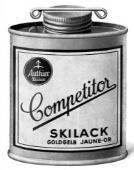
Bases, Edges & Wax
IMAGES
ADVERTS
DIAGRAMS
BASES
The Schoop Company, specialized in metal spraying, prepared in 1916, three skis, two with aluminum, the other with copper sprayed base. They were tried out by the Ski Club Bern in the region of Lenk—the results were disastrous.
In the 30s, many varnishes were sold such as Authier Competitor gold-yellow, A21, Bercolin, B.S. 33, Colpo, Gsellin, Gsellin-Rapid, Gsellin-Silver, Helva, Hürlimann, Lucendi, Maissen yellow, Marga, MIWI, Mulik, Olsen, OP1, Piz Sol, Rekord, SKIBO, Skiolin, Skipolin, Skiwa, Temperol green, Rätia, Rulack, Säntis, TEMPEROL 3 green as well as graphite, Wessco, Unikum and likely many others.
The Beerli base helped several racers to win at the Olympics of St. Moritz (1948). In the 50s, Müller (the founder of Montana Sport, better known as IMS)) introduced the highly successful “P-Tex®” polyethylene base to oxidize the surface (patent of 1952 by Dr. Kreidl, U.S.).
EDGES
In the 30s appeared edges of steel, aluminum, duralumin, brass, and messing, blue celluloid, even horn, of different size and forms, screwed-on or glued, base or side mounted. The most familiar were named Blue, Columbus, Jack Ettinger, G. S. Spezial, G. S. Start, Ideal, Lauberhorn, Parsenn, Parsenn+++, Parsenn Firn, Parsenn Schuss, Parsenn Spezial, Rubi, Silberhorn, Spezial, Schuss, Violett, Weisshorn. Of special design were the Staub without screws, of steel or brass, either as shown on the image or held by small staves introduced from the sides, the Stäubli of alu (1934), the Bärlocher combi edges, violet celluloid with on the side of the skis screwed-on 5 cm steel ones, the Staehli GS, 5 cm with acute bevel and tongue requiring one screw only, considered best by many racers; the Rominger of one piece with a small steel surface enlarged with blue celluloid (which provided faster skis). Beerli patented in 1935 the blue celluloid edges, often used for the ski’s upturn, Inter Montana Sport (IMS) sold in 1972, the exclusive rights for cracked VCE edges to Olin-Authier.
WAXES
TOKO, well known by alpine and cross-country skiers, was founded by Jakob Tobler in Altstätten (1916) for products caring footwear and leather goods. Its first ski product was Skigliss, a red-colored varnish and Skimont for ski bases sold under the Toko brand (1933). It was followed by rub-on wax 1-3-5 (1940), SKIGLISSIN and Olympiawax Combi blue-red-green (1948), Paraffin-Skiwax (1969), System 4 (1974), hot waxes (1975), System Elite (1979), World Cup Wax (1985), Wet Jet and Streamline, first fluorinated waxes (1989), Dibloc (1991), Nordlite Molydenum (1996) and HelX (2002). Several Olympic and World Champion-ship winners in alpine, Nordic as well as snowboard disciplines relied—and still rely on Toko. They also sold wooden cross-country skis as of 1971 and fiberglass as of 1974, both made in Sweden. In 1972 they launched a magnetic alpine binding but as it opened unreliably was retired from the market. Toko was absorbed in 2002 by the Mammut Sports Group before become part in 2010 of the Swix Sport, a Norwegian Company with products for tuning skis and boards as well as accessories for outdoor activities.









